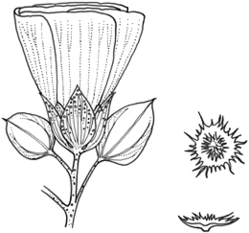
Description: Perennial or facultative annual shrubs, often deciduous.
Leaves entire or variously lobed, mostly 3–5-lobed, glabrous to pubescent.
Flowers usually solitary, rarely clustered, axillary. Epicalyx segments 3, narrow to cordate, entire or deeply cut. Calyx short, truncate, 5-toothed or 5-lobed. Petals often large, usually with a darker area at the base. Ovary 3–5-locular; loculi with 2–several ovules; style and stigma usually long and slender.
Fruit a capsule, 3–5-locular; seeds usually hairy.
Distribution and occurrence: World: c. 40 species, tropical & subtropical regions. Australia: 12 species (9 species native), Qld, N.S.W., N.T., W.A., chiefly tropical & subtropical
Some species are cultivated for the long hairs which cover the seeds forming the material known as cotton. Oil is obtained by crushing the seeds (cotton-seed oil).
Text by A. S. Mitchell & E. H. Norris
Taxon concept:
| | Key to the species | |
| 1 | Petals mauve; embryos with no (or very few) glands | Gossypium sturtianum |
| Petals cream or yellow; embryos with prominent glands | 2 |
| 2 | Fruit with no commercial, or obvious, cotton hairs; epicalyx segments linear or with a few teeth at apex; at least the lower leaves deeply lobed almost to base | Gossypium thurberi |
| Fruit with commercial and obvious cotton hairs; epicalyx segments usually laciniate or deeply incised; leaves entire or lobed to c. midway
Back to 1 | 3 |
| 3 | Capsule 3–5-locular, ovoid to more or less globose; stipules 5–20 mm long; leaves 3–5-lobed, the central lobe usually 1–1.5 times as long as broad | Gossypium hirsutum |
| Capsule usually 3-locular, narrow-ovoid; stipules 1–5 cm long; leaves 3–7-lobed, the central lobe usually more than 1.5 times as long as broad
Back to 2 | Gossypium barbadense |
|


